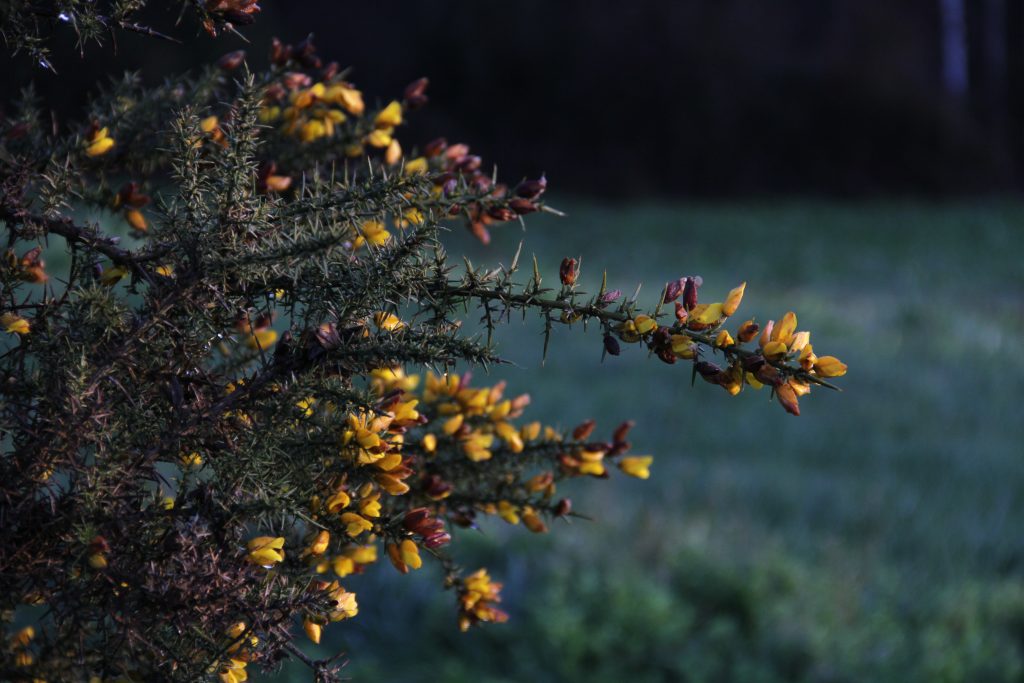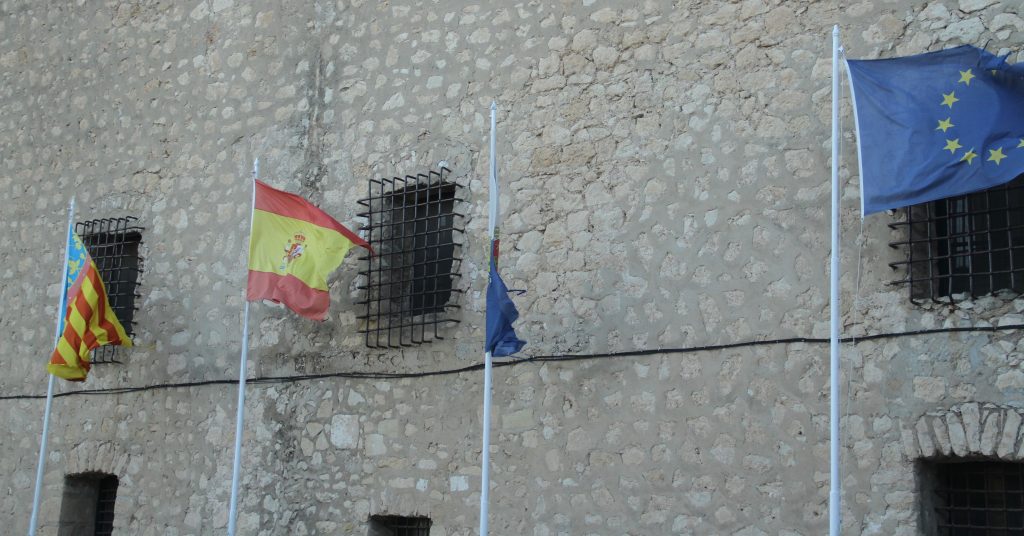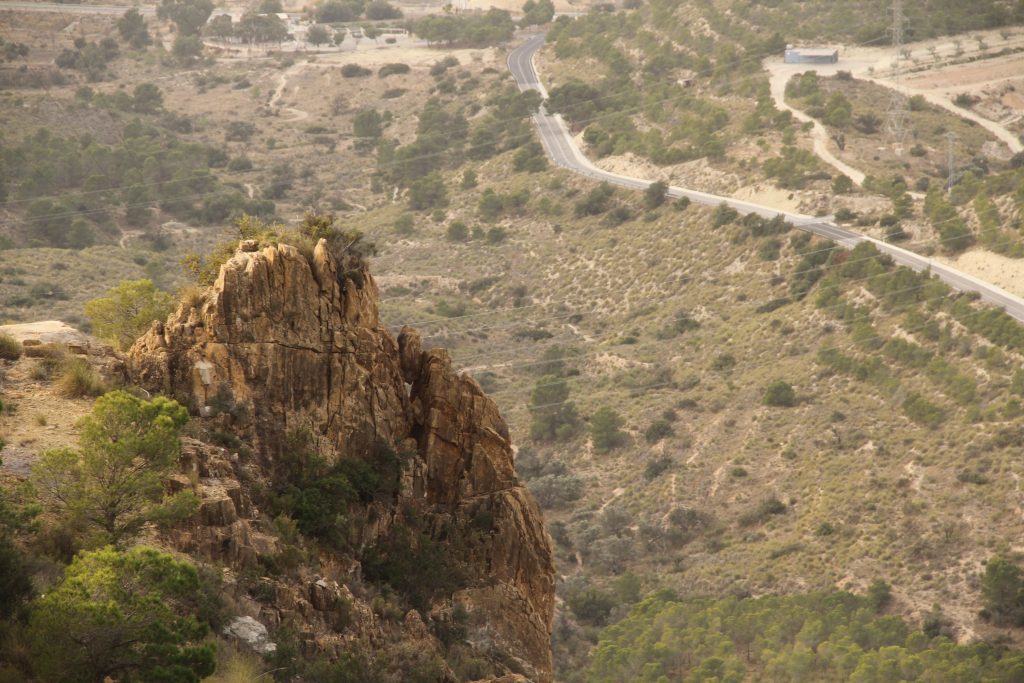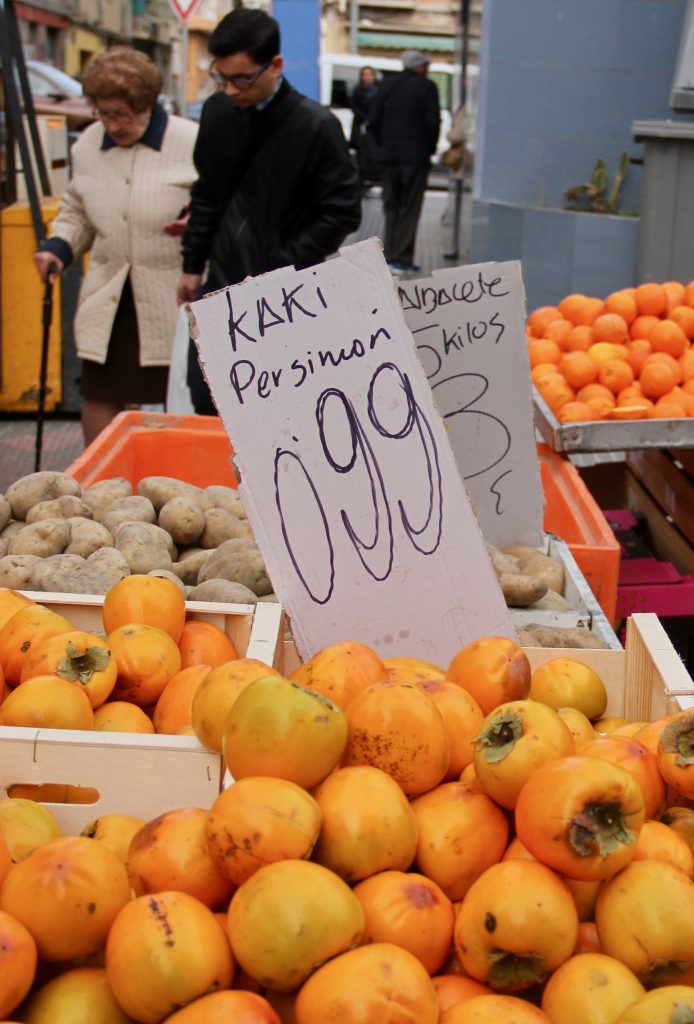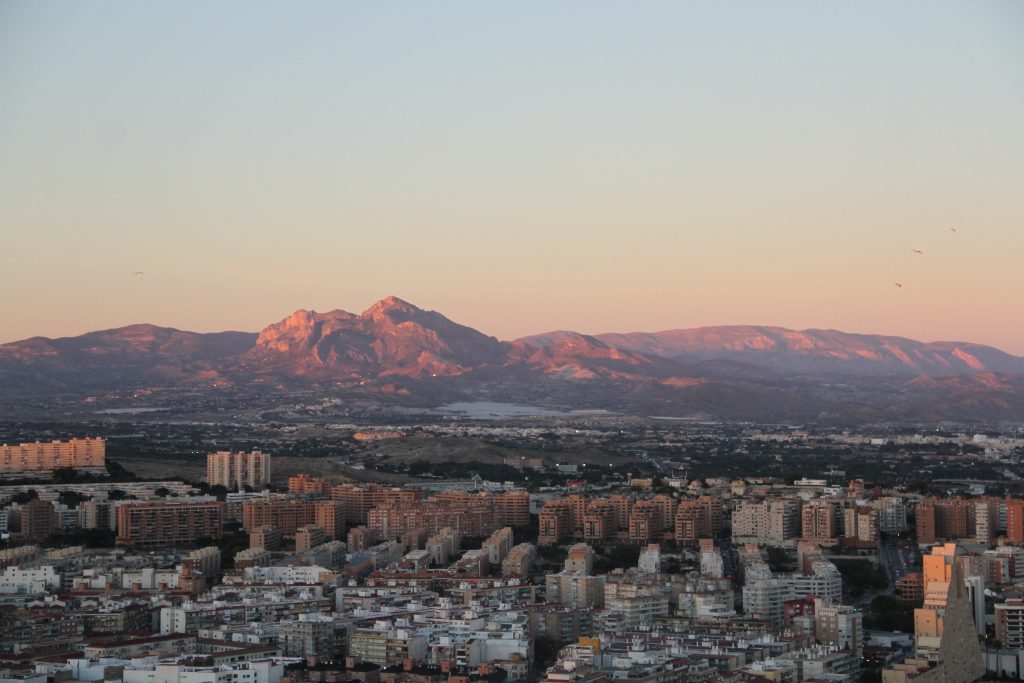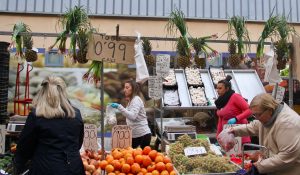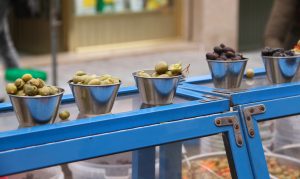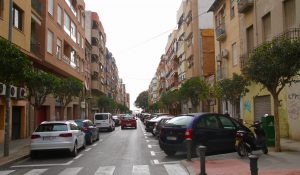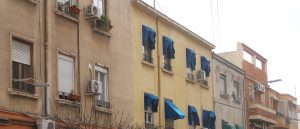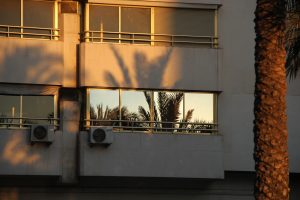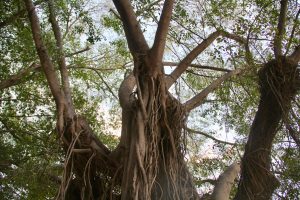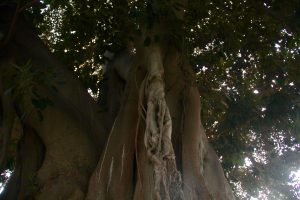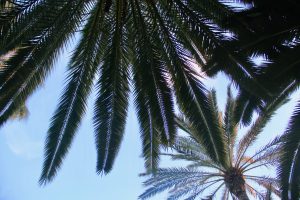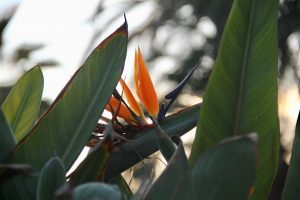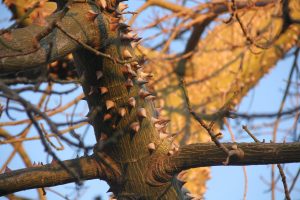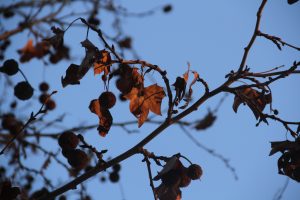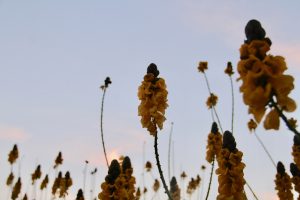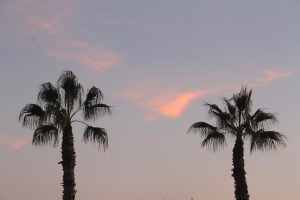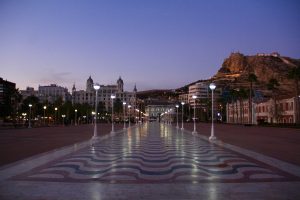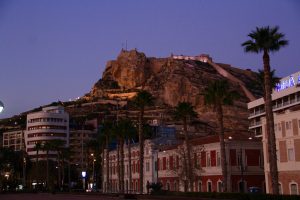Over the course of the journey to Santiago, I kept a journal of my daily activities, thoughts, feelings, challenges, and interactions with others along the way. Below are snippets of journal entries from each day – every experience on the Camino is distinct and different, but I hope these snippets can paint a little image of mine.
29 de marzo: travel to Sarria
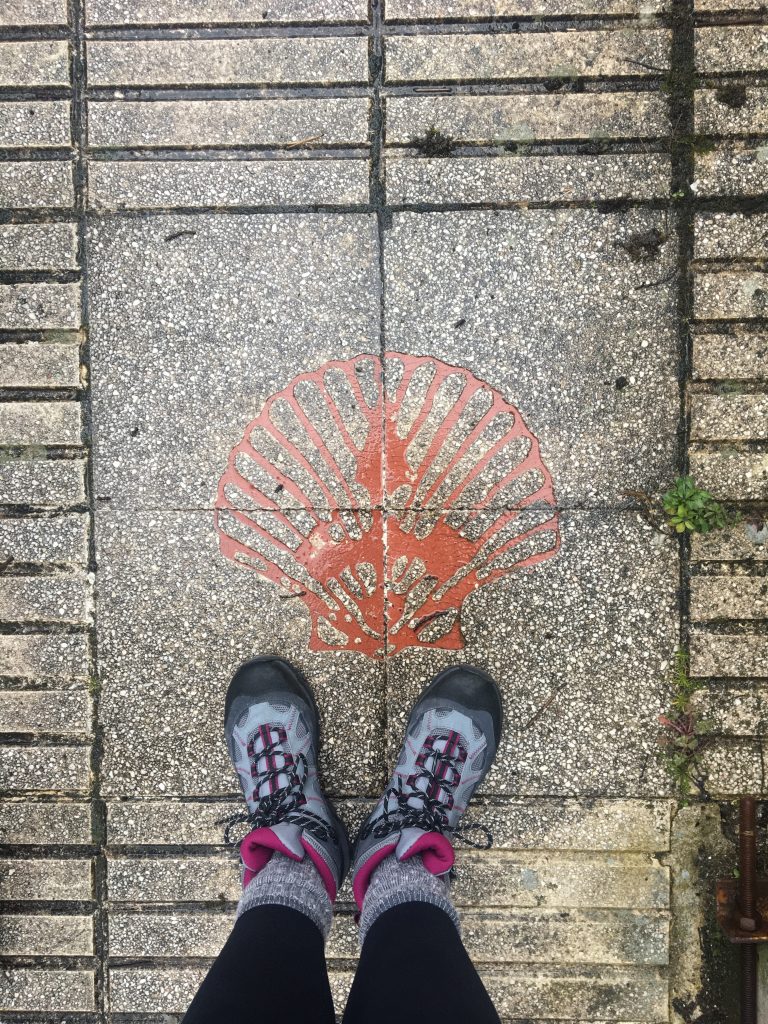
The seashell is a popular symbol of the Camino, and many shell markers orient peregrinos in the direction of the path. Here my boots are relatively clean and dry – just wait till we get to Santiago…
I woke up before my alarm this morning, excited and nervous to start the first leg of the journey. My host mama’s family has been in town visiting for Semana Santa, and I could hear her little grandchildren in the kitchen eating breakfast: “‘buela, ‘buela!” It’s strange to think I won’t be home for a whole week. I had all of my materials laid out two days ago, but I just packed them into my little backpack today. The heaviest thing in my backpack is my camera, and I wonder if I’ll even use it – the forecast reads rain all week. I’ve been pretty sick for the past three weeks but am feeling better now. I tell myself the fresh air and humidity will do me good, but we’ll see! I wonder how I’ll feel, hour-to-hour and day-to-day. The Camino is so ,much more than academic for me, and I’m hoping to allow myself explore all the aspects – emotional, spiritual, physical – along the way.
We landed in a world of green at the Santiago airport. Walking off the plane, we were immediately hit with the rain and cold, quite a change from the sunny and warm Alicante we had left behind. From Santiago we took a bus to our starting point, the town of Sarria. Our group of nine cracked jokes about walking five days when we could simply hop on a bus for two hours. But, cliche as it sounds, the walk is perhaps just as important as, if not more important than, the destination. I looked out the window as we passed swaths of evergreen trees, lichen, moss, pasture, and eroded stone walls, wondering if I could see our path from the road.

To obtain the compostela after arriving in Santiago, I had to verify that I walked over 100km of the Camino. To do this, I collected at least two stamps per day in the albergues, bars, and churches that I passed through in every town.
Arriving in Sarria was my first experience of a town in northwestern Spain. The weather and plants reminded me of my home in Washington – ferns dripping with dew, cherry trees just about to bud, buildings covered in soft damp moss, trunks of trees enrobed in ivy. After checking into our albergue (a hostel of sorts for people walking the Camino), our professor and guide, Alfonso, showed us around two Catholic churches in town, one from the 13th century. Alfonso has been walking the Camino at least once a year since he was 18, and is an absolute wealth of knowledge on the history and current practice of the Camino de Santiago, as well as it’s surrounding art, architecture, history, and gastronomy. At our albergue and the churches we filled our pilgrim credentials with the first stamps from the Camino. We ate a hearty dinner of thick bread, caldo gallego (broth specific to Galicia), and tarta de Santiago (a delicious almond cake decorated with the cross of St. James). Full and content, we went back to the albergue where a warm fire was burning in the hearth. I met several other Spanish students who were starting in Sarria, and we attempted a song while one played the guitar – we found some common ground in the Red Hot Chili Peppers, and shared orujo, a liquor typical of northern Spain. Not too much, of course – tomorrow morning we’re walking 22km in the wind and rain, and we’ll need some good sleep.
30 de marzo: day 1 – 22km
Today was our first day of walking, from Sarria to Portomarín. Our walk began with a rainbow (“arcoiris,” en español – that was a new word for me). It was a beautiful, fresh morning. We ate our breakfast of hearty bread and café con leche and were on the road by 08:00. The morning sky faded from pink to blue as we walked past cemeteries, churches, houses, and stone walls, out of the city. The sun was out for the first hour or so, lighting up the buildings and trees in start contrast to the grey, massive storm on the horizon. As we walked through pastures, forests, and divided plots of land, the rain began to fall and I donned my poncho as the path transitioned from dirt to mud to river. The first snowflakes started to fall at midday, and soon it was an impressive flurry.
At 8km I could feel my knees getting a little sore, my shoulders tightening from the weight of my pack. At 15km my boots were soaked through, and that’s about when I heard the first roll of thunder. Throughout the walk our group spread out periodically, each person walking at a slightly different pace. We tried to stick together during the snow and rain and river-path, boosting morale with conversation and lending a hand when we had to leap from one side of the path to the other, or hop from rock to rock to avoid the fast-running water.
We arrived at the albergue in the afternoon absolutely drenched and freezing, and I can’t remember a time where I was more thankful for a hot shower. My whole body hurts, partly from regaining feeling from the cold, but also from walking farther than I have in a while. It made me think about why I’m walking – what drew me to this experience? After only a day, I have seen so much of the landscape that I otherwise would not have seen. I’ve missed the rain and the moss and the trees from home in the US. Although time was mostly spent walking in small groups of two or three, I also had moments of quiet reflection while the snow fell and the only sounds were my footsteps, the sloshing of boots and splashing of puddles.
31 de marzo: day 2 – 24km
I woke up this morning with a sickness in full-force: fever, swollen lymph nodes, throat swollen and red, and I was a little freaked out. I had been sick for practically all fo March, but had started to feel recovered before our 120km walk. The snow probably hadn’t helped in my recovery process. The weather today was much nicer, but it was pretty tough to get out of bed with a fever, let alone walk 24 km. What’s the Camino without at least a little suffering?
Early morning fog nestled between rolling hills, and soft light illuminated the textures of the tree trunks and filtered through wet leaves. Snow from the previous day still lingered in pastures.
One of my favorite moments from the day was walking through a pueblo when a woman leaned out of the window where she was making fresh cheese and asked if we wanted to try some – it was lovely. Alfonso bought a wheel and we chatted for awhile before continuing on. She also had a great dog – he was a real morale booster.
Once we arrived in Palas de Rey, our stop for the night, we shared a fantastic meal, another menu del día, with a primero, segundo, and postre. It sounds like a lot of food, and it certainly is, but we always devour it after 6 hours of walking. After returning to our albergue, I had another special cultural experience by going to the medic in town to see what’s up with my throat – it felt like I might’ve need the help of antibiotics. Alfonso accompanied me and we had a great discussion about the healthcare system in Spain while waiting to see a doc. They did some tests and determined it’s not strep or rheumatic fever, which I guess would have been the most worrisome. Most of the visit was spent talking about the Camino, how it’s changed over the years, which route we were doing, which town we started in, etc. I was relieved that the doc didn’t seem worried – he suggested I consider taking a bus to the next town tomorrow and meeting the group there, but if I walk it probably won’t make things worse. It’s hard to swallow and tough to breathe, but I am really going to try to make it the 26km to Ribadiso. We’ll see what tomorrow brings. As my host mama always says, “Mañana, más y mejor.”







